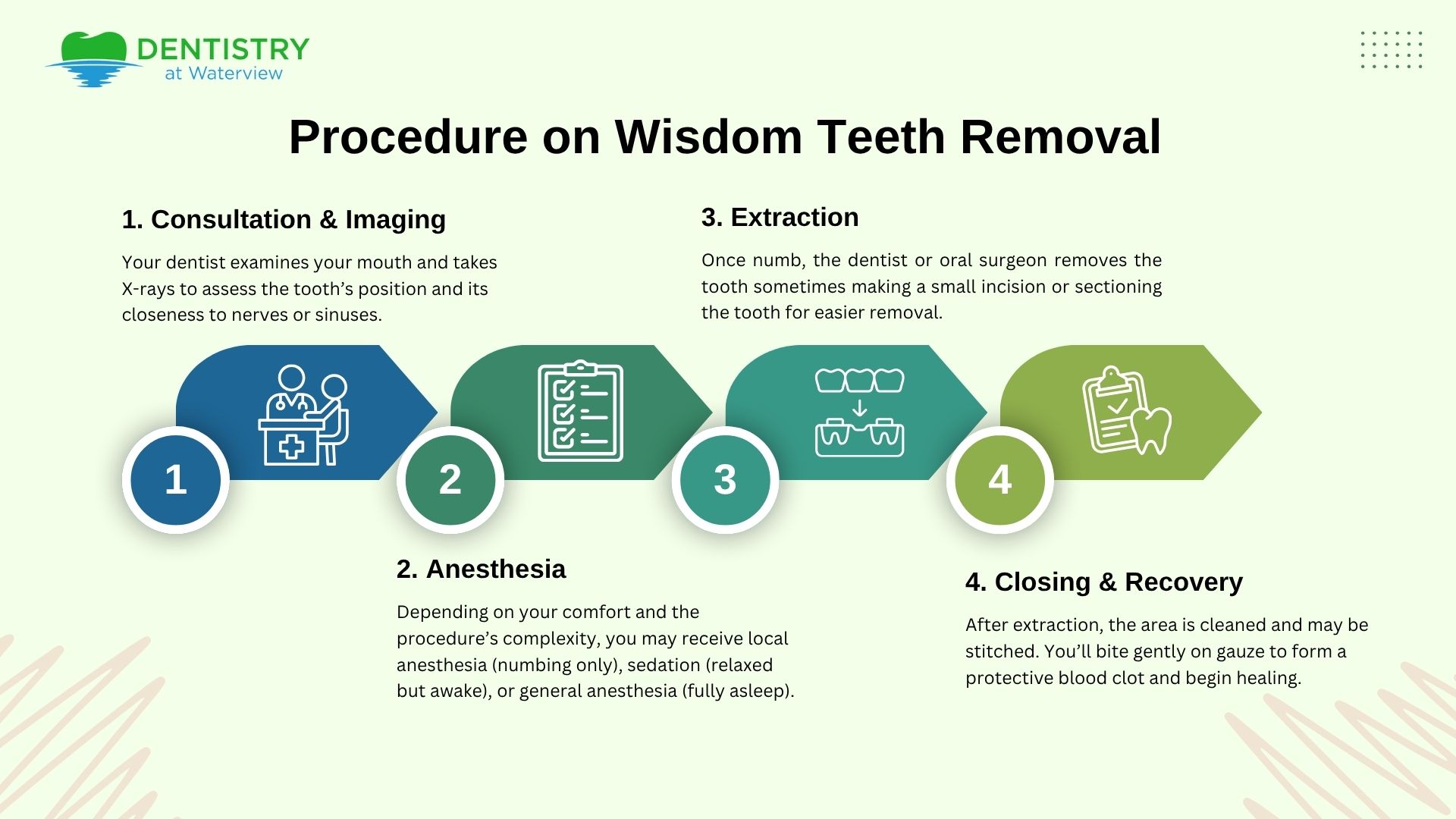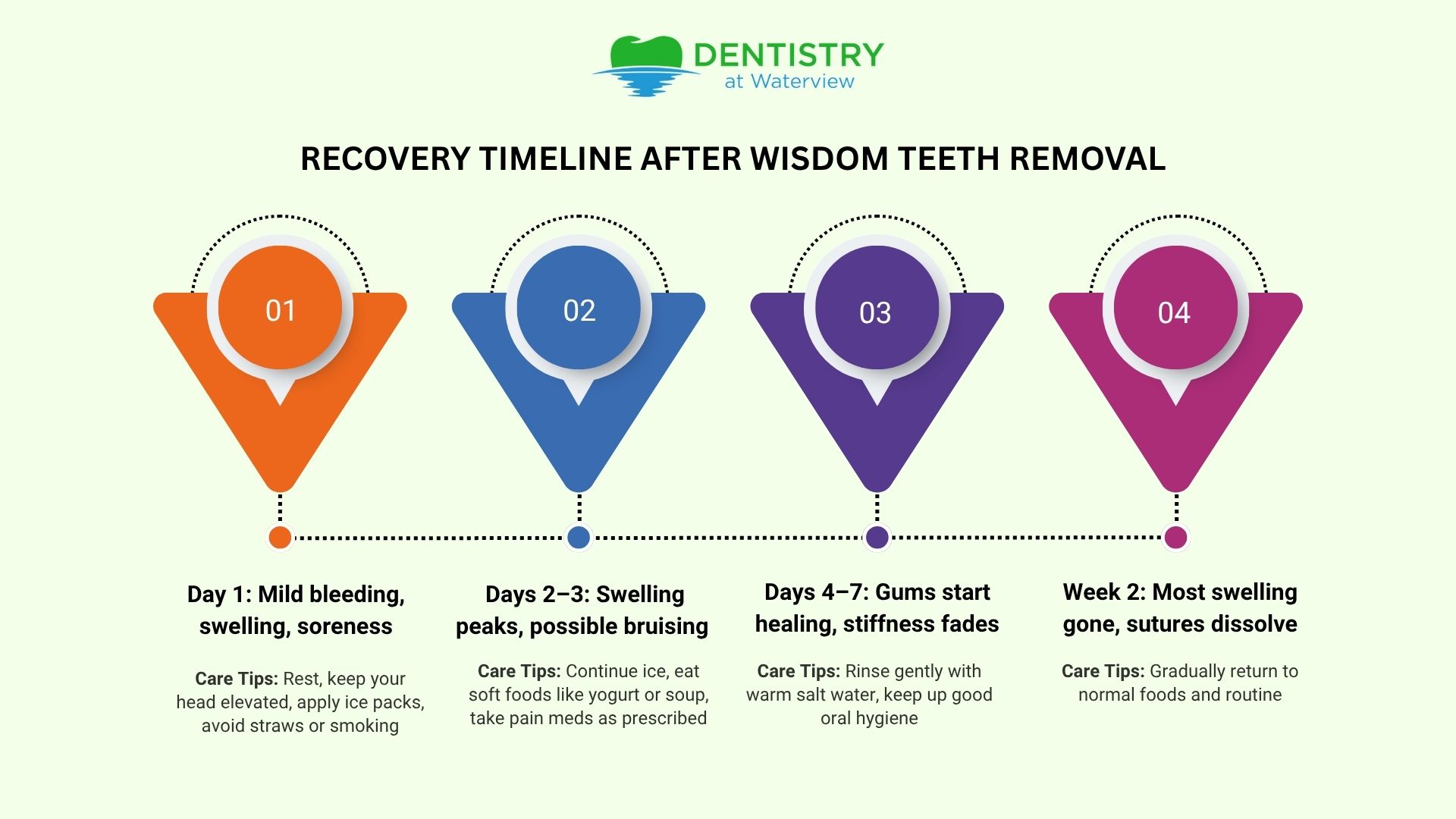Wisdom teeth removal, also known as extraction, is a common dental procedure to remove one or more of the four permanent adult teeth located at the back corners of your mouth — on the top and bottom.
These teeth, also called third molars, are the last to appear and often emerge in the late teens or early twenties. Sometimes, there isn’t enough room for them to grow properly, causing them to become impacted (trapped under the gum or bone).
An impacted wisdom tooth can lead to pain, infection, or other dental problems. In such cases, your dentist or oral surgeon may recommend removing the tooth to prevent further issues. Even if they aren’t causing discomfort now, some dental professionals advise early removal to avoid potential complications later in life.
Read more about All-on-4 Dental Implants vs. Dentures vs. Individual Implants: A Complete Guide
What Are Wisdom Teeth?
Wisdom teeth, also called third molars, are the last set of teeth to erupt usually between ages 17 and 25. For some, they grow smoothly and cause no issues. For others, there’s simply not enough space, leading to impaction when teeth are trapped under the gums or bone.
Impacted wisdom teeth can grow sideways, push against neighboring molars, or only partially emerge. Over time, this can lead to:
- Gum pain or swelling at the back of your mouth
- Difficulty cleaning and flossing properly
- Jaw stiffness or tenderness
- Tooth decay or gum disease
- Cysts or infections around the tooth roots
If left untreated, these conditions can cause lasting oral damage. According to the Mayo Clinic, early evaluation and removal often prevent more serious complications.
When Do Wisdom Teeth Need to Be Removed?
Not everyone needs their wisdom teeth extracted. In fact, if your wisdom teeth are healthy, fully erupted, aligned correctly, and easy to clean, your dentist may recommend leaving them in place.
However, removal is often advised if:
- They are impacted or growing at an angle.
- They’re causing pain, swelling, or infection.
- They risk crowding or shifting other teeth.
- They are damaging nearby teeth or bone.
- There’s a cyst or decay developing under the gum.
Dentists typically assess this using a panoramic X-ray or CBCT scan. Early evaluation often in your late teens or early 20s allows for simpler extractions and faster recovery.

What Happens During Wisdom Teeth Removal?
Wisdom teeth removal is one of the most common oral surgeries worldwide. While each case is different, the general process includes:
1. Consultation & Imaging
Your dentist examines your mouth and takes X-rays to evaluate tooth position, roots, and proximity to nerves or sinuses.
2. Anesthesia Options
Depending on the complexity and your comfort level, your dentist may use:
- Local anesthesia – numbs the area (you stay awake)
- Sedation anesthesia – helps you relax but keeps you semi-awake
- General anesthesia – fully asleep for complex extractions
3. Extraction
After the area is numb, the dentist or oral surgeon makes a small incision in the gum if necessary. Sometimes, a bit of bone is removed or the tooth is divided into sections for easier extraction.
4. Closing & Recovery
Once removed, the site is cleaned and may be stitched closed. You’ll bite on gauze to help a protective blood clot form, which is crucial for healing.
What to Expect After Wisdom Teeth Removal
Recovery from wisdom teeth removal usually takes one to two weeks, depending on the number of teeth removed and the complexity of the surgery. Here’s a quick look at what’s normal during recovery:

What to Eat After Wisdom Teeth Removal
Eating soft, nutritious foods helps your body heal faster and prevents irritation at the extraction site.
✅ Best foods to eat:
- Yogurt, smoothies, applesauce
- Mashed potatoes, oatmeal, and soup
- Scrambled eggs or soft pasta
🚫 Avoid for at least 5–7 days:
- Chips, nuts, popcorn
- Spicy or acidic food
- Hard bread or crusts
- Alcohol and carbonated drinks
For the first 24 hours, stick to cool or room-temperature meals. Avoid using straws — the suction can dislodge your healing clot and cause a dry socket.
Should I Brush My Teeth After Wisdom Teeth Removal — and How?
Yes, but with care. Brushing is important to prevent infection, but you should avoid disturbing the extraction site. Here’s how to do it safely:
- Wait at least 24 hours before brushing near the surgical area.
- Brush your other teeth gently with a soft-bristled toothbrush.
- Rinse gently with warm salt water starting on day two (½ teaspoon salt in 1 cup of water).
- Avoid strong mouthwash or vigorous rinsing for the first few days.
By day 4 or 5, you can resume normal brushing habits — just continue being gentle near the healing area.
How Much Does Wisdom Teeth Removal Cost in Canada?
The cost of wisdom teeth removal in Canada varies because every case is different. Factors like the number of teeth being removed, whether they’re impacted, the type of anesthesia used, and whether it’s done by a general dentist or oral surgeon all play a role. Generally, simple extractions are more affordable, while complex or surgical cases that require additional time and sedation tend to cost more.
💡 Insurance Coverage in Canada
Most dental insurance plans (including private or employer-based plans) cover up to 50% of the procedure, especially when the removal is medically necessary. If you’re not covered by insurance, some clinics like Dentistry at Waterview offer payment plans options to make your treatment more affordable.
💬 Tip:Before your procedure, ask for a detailed estimate that includes the X-rays, anesthesia, and follow-up appointments. This ensures transparency and helps you understand the total investment upfront. On average, removing all four wisdom teeth in Canada costs between CAD $1,000 – $2,000, depending on the level of sedation and complexity.
🦷 Final Word
Wisdom teeth removal doesn’t have to be painful or scary. With modern techniques and the right aftercare, it’s a smooth, safe procedure that supports your long-term dental health.
If you’re in Grimsby or nearby Ontario, schedule your visit with Dentistry at Waterview — where expert hands, caring hearts, and modern technology meet to make your smile stronger, healthier, and pain-free.
Frequently Asked Questions (FAQ)
- Do I have to remove my wisdom teeth if they don’t hurt?
Not necessarily. If they’re healthy and easy to clean, you can keep them — but regular monitoring is essential since problems can develop silently. - How long does recovery take?
Most people feel normal again within 3–5 days, though complete healing takes about two weeks. - Does wisdom teeth removal hurt?
You won’t feel pain during the procedure thanks to anesthesia. Mild soreness afterward is normal and manageable with medication. - What to eat after wisdom teeth removal?
Soft foods like smoothies, soup, or mashed potatoes are ideal. Avoid hard, spicy, or hot foods until the area heals. - Should I brush my teeth after wisdom teeth removal?
Yes — start gently after 24 hours, avoiding the surgical site. Use soft bristles and rinse with warm salt water. - How much does wisdom teeth removal cost?
Costs vary but generally range between $150–$800 per tooth, depending on complexity and anesthesia. Insurance may cover part of it. - Does removing wisdom teeth change face shape?
Only minimally. Any difference you see is likely from reduced swelling or pressure, not bone structure changes. - Does Removing Wisdom Teeth Change Face Shape? This is a popular myth and the answer is mostly no. Removing wisdom teeth doesn’t change your facial bone structure or shape. However, some people notice a slight slimming or less puffy look around the jaw once swelling and pressure subside, especially if the wisdom teeth were pushing against other teeth.
Read more about the latest health trend in 2025
